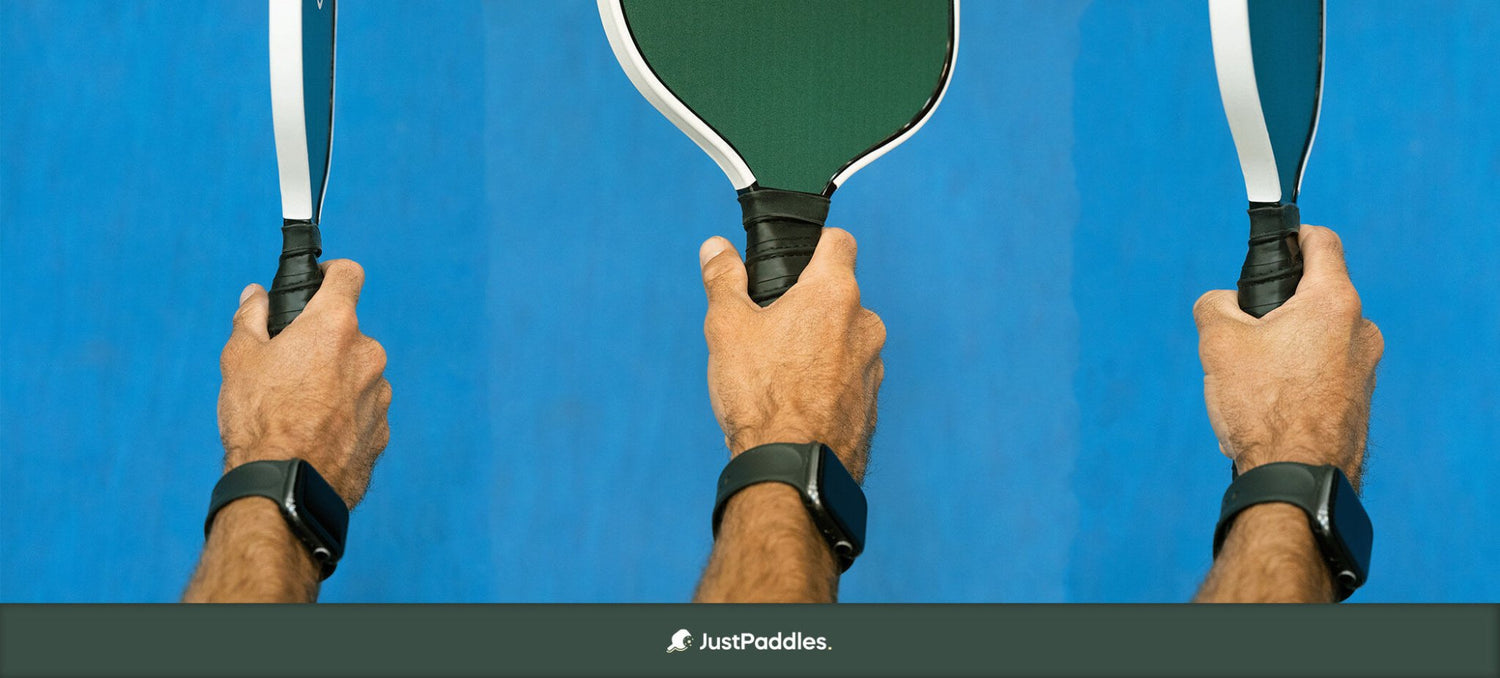
How to Hold a Pickleball Paddle
If your grip is wrong, every shot fights you. Fix the hold, and the ball starts obeying. This guide walks you through how to hold a pickleball paddle so your drops sit soft, your volleys stay clean, and your drives feel honest.
Start with the neutral “shake-hands” grip
Stand tall. Hold the paddle out as if you are shaking someone’s hand. Slide your palm onto the handle so the V between your thumb and index finger points toward the top corner of the paddle face. That is the neutral grip. It centers the face, keeps the wrist relaxed, and lets you switch from forehand to backhand without drama. If the handle has bevels, rest your index knuckle on the top bevel. If it is rounded, keep the V slightly off center toward the forehand side.
Grip pressure that actually works
Think of pressure on a scale from one to ten. Aim for a four during dinks and drops. The paddle should feel alive, not clamped. Tighten to a six or seven only when countering pace or driving a sitter. If your knuckles whiten, you are squeezing too hard. A soft hand absorbs speed and gives you touch. A death grip sprays balls long and slow.
Finger placement and wrist position
Wrap all fingers, but leave a small gap between the index finger and the others. That “trigger” space improves control and stops the face from wobbling. Keep the wrist neutral. No cocked wrist on routine shots. A neutral wrist sets a flat path and a predictable face angle. On delicate dinks, tip the face slightly open and brush up the back of the ball. On flat drives, square the face and lead with the knuckles.
Forehand and backhand switches
From neutral, rotate the paddle a quarter turn for a firmer forehand. For a backhand, rotate the V slightly toward the backhand side and move the off-hand to the throat of the paddle to steady the change. Make the switch while the ball is still traveling toward you, not at the last second. Practice slow feeds until your hand can flip grips without looking down.
Ready position that supports the hold
Good holding starts before contact. Stand with the paddle up in front of your chest, tip just above eye level, elbows in, shoulders relaxed. That puts the sweet spot in the path of most incoming balls. If the paddle hangs by your hip, you will keep stabbing late, and your grip will tense to catch up. Quiet body, quiet hands, quiet face.
Common mistakes and quick fixes:
- Paddle face drifting open on blocks: lower the handle a touch and soften your hand.
- Scooping dinks into the net: bend the knees, not the wrist, and brush up the back of the ball.
- Drives sailing long: reduce pressure to a five and finish forward, not upward.
- Slipping grip mid-rally: add an overgrip, dry your hands, and check that index finger gap.
Two short drills to lock it in
Wall taps. Stand six feet from a wall. Tap the ball forehand to forehand for thirty seconds, then backhand to backhand, then alternate every tap. Focus on a neutral wrist and a light four on the pressure scale.
Kitchen ladder. At the non-volley line, drop ten balls so they land just over the net, then ten to mid-court, then ten deep. Hold the paddle the same way each time and let the arm swing small and steady.
Practice plan
Mastering how to hold a pickleball paddle is about repeatable setup and relaxed hands. Start neutral, keep pressure light, shape the face with your wrist in the smallest possible range, and switch grips early. Do that, and your shots start working without new mechanics or a new paddle.
Read our How to Choose a Pickleball Paddle Article. Image credits: Pexels
FAQ
Should I hold the paddle tighter on hard volleys?
Slightly tighter, yes, but never a clamp. Move from a four to a six on the pressure scale. Let the paddle meet the ball in front of your body with a short punch. The frame, not your forearm, should take the load.
Is the backhand two-handed or one-handed at the kitchen?
Either works. One hand is quicker in hand-to-hand battles. Two hands add stability for blocks and counters. Try both during wall taps and keep the one that holds face angle best under pressure.
FAQ
Should I hold the paddle tighter on hard volleys?
Slightly tighter, yes, but never a clamp. Move from a four to a six on the pressure scale. Let the paddle meet the ball in front of your body with a short punch. The frame, not your forearm, should take the load.
Is the backhand two-handed or one-handed at the kitchen?
Either works. One hand is quicker in hand-to-hand battles. Two hands add stability for blocks and counters. Try both during wall taps and keep the one that holds face angle best under pressure.